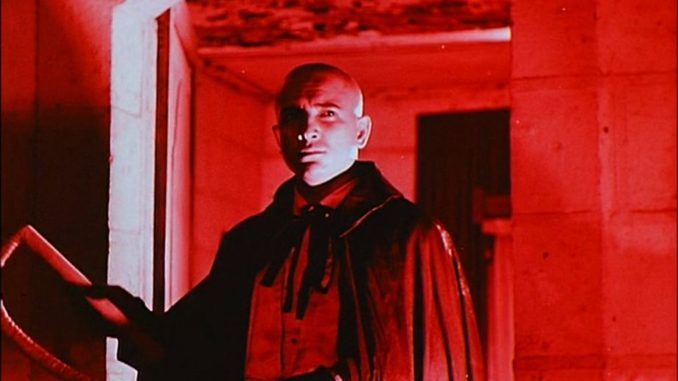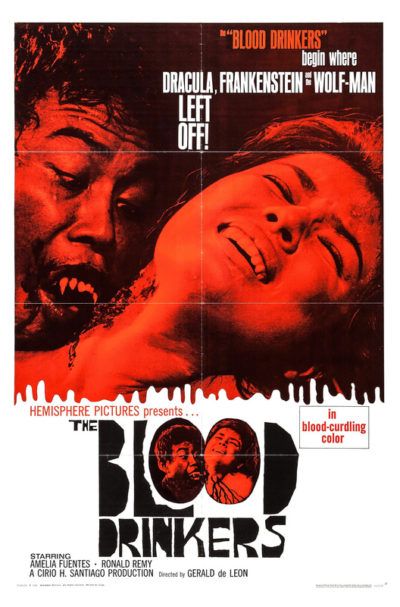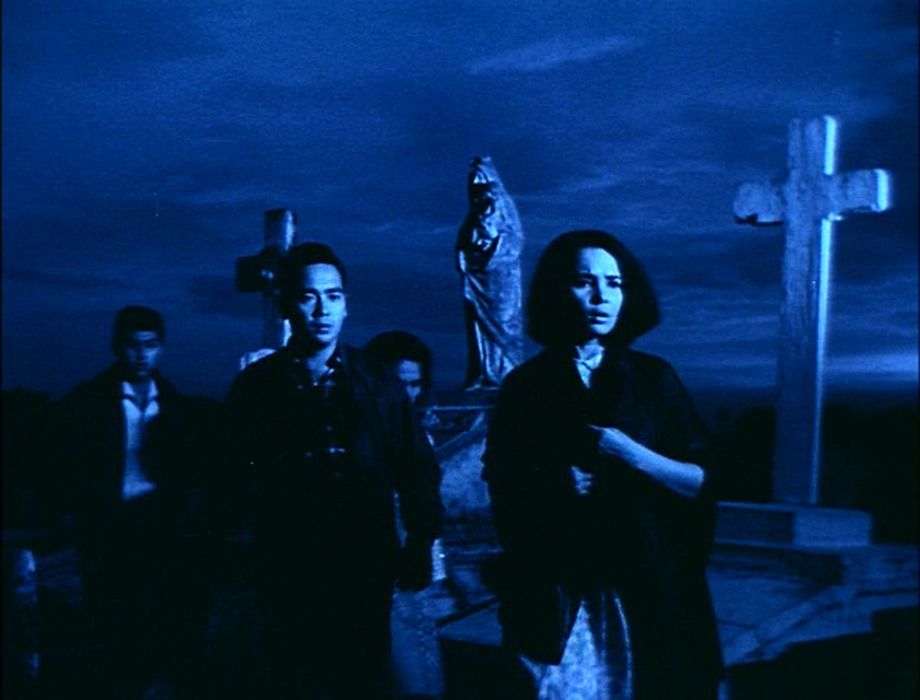
Rating: B-
Dir: Gerardo de Leon
Star: Ronald Remy, Amalia Fuentes, Eddie Fernandez, Eva Montes
a.k.a. Blood Is the Color of Night and Kulay Dugo Ang Gabi
This was a bit of a surprise. I’d be hard-pushed to call this a good movie, yet in the words of Maximus Decimus Meridius, “Are you not entertained?” Oh, yes: I was. It’s likely one of a kind, with a slew of elements I’d not seen before. The vampire at its core would be one. Dr. Marco (Remy) is not just a supernatural blood-sucker. He is also a man of science, devoted to curing his true love, Katrina (Fuentes). Doing so requires a heart transplant, and fortunately, there’s an ideal donor available, in the shape of her long-separated twin sister, Charito (also Fuentes).
Marco and his entourage move to the town where Charito lives, in preparation for the surgery. But it’s not long before they are drawing the wrong kind of attention – and not just because that entourage includes a midget, a hunchback and a gigantic rubber bat called Basra. Marco’s nocturnal predations soon are provoking the ire of the local authorities, as well as Charito’s boyfriend, Victor (Fernandez). He attempts to raid the doctor’s estate, only to get his ass kicked, and there’s not enough actual evidence for the police to do anything. Fortunately, there’s a convenient priest, who is a fountain of wisdom on vampires and their ways, including a detailed scientific explanation of why wooden stakes are so effective against them. Just in time, for as Charito heads towards her doom on Dr. Marco’s operating table, so does a mob of angry villagers with torches, policemen with guns, and an annoyed Victor, looking for a rematch.
 Later in the decade, and on into the seventies, a lot of the Filipino produced movies were made more for the American market, through studios like Roger Corman’s New World. But this was originally intended for the local market. Hemisphere Pictures had found some success in the West with an earlier de Leon picture called Terror is a Man, based on H.G. Wells’s “Island of Dr. Moreau” and renamed Blood Creature for the overseas market. Here, they again edited, dubbed and re-titled the film, with the aim of making it more appealing to an international audience.
Later in the decade, and on into the seventies, a lot of the Filipino produced movies were made more for the American market, through studios like Roger Corman’s New World. But this was originally intended for the local market. Hemisphere Pictures had found some success in the West with an earlier de Leon picture called Terror is a Man, based on H.G. Wells’s “Island of Dr. Moreau” and renamed Blood Creature for the overseas market. Here, they again edited, dubbed and re-titled the film, with the aim of making it more appealing to an international audience.
What stands out in particular is the visual style. While touted as “The first colour horror picture produced in the Philippines” – indeed, that’s the synopsis in the IMDb – it’s a bit more complex than that. Only some of the movie was shot on color film; reports vary on whether this was done to save money, or simply because there wasn’t enough available stock. Regardless, the rest was shot on black-and-white film, which was then tinted in a broad range of hues. While blue and red are the most common, green and even orange show up. It’s occasionally an in-plot thing too: “There seems to be a red glow, let’s go back there,” says a character at one point.
Let me be clear though: “tinted” implies a degree of subtlety and understatement, which would be entirely misleading. I’ll refer you to the stills above and below, which are untouched captures of the approach taken by the makers. “Hurling buckets of primary colours at every frame,” would be close to the truth. Yet, the surprising thing is, it works, much better than you’d expect – at least once you’ve got used to the technique. While definitely not the sort of thing I’d want to see every day, it ensures that The Blood Drinkers will be remembered far better than many, more polished entries in this series. It’s the kind of outrageous and brave stylistic choice which it feels like only a true cinematic auteur would dare to attempt, rather than a low-budget director, churning out work for the local market.
There are a couple of other elements which also made us sit up and take notice. At one point, Dr. Marco uses a gun. I can honestly not think of any other time I’ve seen a vampire wield a firearm. At the end, when he’s attempting to escape from the mob in the darkness, Victor launches flares, the light from which paralyze his nemesis. Again, not something I’ve seen before. However, the whole “vulnerability to light” thing seems a bit variable. There’s an earlier sequence where Marco wanders through some gardens in broad daylight, without an apparent care in the world, nor any SPF three million sunblock on.

There are times when the film does achieve a genuine eeriness, such as when Charito’s dead parents return from the grave for a visit. However, the most fun I got out of it was in the sillier moments. My favourite scene was likely the one where Victor has an lengthy brawl with two of the Doctor’s minions, who just happen to be a hunchback and a midget. “This is just… wrong,” may have escaped my lips on more than one occasion, not least when the little person got flung through the air. It felt more like the main event at a wrestling freak-show: in the interest of ability awareness and solidarity, I was cheering for the gimps by the end.
I will say that Remy has screen presence. The offbeat nature of his vampire is a pleasure to watch, and the “doomed love” elements left me feeling a surprising amount of sympathy for him. It’s also one of the more straightforwardly religious entries. At the end, we are explicitly told, “Yes, Satan will be with us always on this Earth. His power can be stopped only if we take to heart and believe in the power of Jesus.” Giving the way Catholicism was deeply entrenched in the Philippines at the time, this is likely not surprising. It’s just another notch on the weirdness belt, for a movie that manages to overcome its limited resources through an admirable combination of pluck and refusal to give a damn.
This review is part of our October 2023 feature, 31 Days of Vampires.
